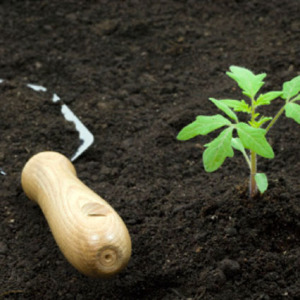Autumn and spring off-season - it's time for the construction of a warm bed. Its arrangement is to create a multi-layered "cake" of organic waste - through a gradual process of decay of plant residues begin to generate heat required for early cultivation whimsical thermophilic cultures.
There are several ways of arrangement warm bed. So, if in the area the water table is deep enough, it is advisable to lay the sunken beds. Their equip follows: at a selected location skim turf and dig a trench 60-70 cm deep, then laying in the ditch and a layer of organic feed of fertile soil. Ready-made bed will flush with the ground portion or a little below it. Raised beds - the best option for wet areas. For the construction of such ridges on the surface of the earth side is set from scrap materials (slate, brick or boards). Further formed box filled organic and sprinkled pochvosmesi. The higher the fence, the exalted will be ready bed.
- To fit the base and harsh dolgogniyuschie waste - branches, twigs, small stumps, large wood chips and other wood trim. Optionally, use coarse fiber cloth and stems of the plant (e.g., corn or Jerusalem artichoke). The thickness of the base layer - at least 45-50 cm.
- On top of the wood is laid different plant waste - flower stalks, weeds, potato peelings, vegetable tops. For proper aeration beds moist vegetation necessarily interbedded carbonaceous raw material - chopped branches, fallen leaves, weathered sawdust or straw. The thickness of the second layer - 20-25 cm.
- Over the intermediate layer, garden ground is laid, mixed with wood ash and a weathered compost or overwhelmed manure. The thickness of the outer layer is about 15 cm. At the end of the arrangement, the warm bed is covered with a dense black film or a cutteroid cut - for additional warm-up and protection against seeds of weed herbs.
- to arrange a garden, a spacious and sunny place is chosen;
- before laying each new layer, the previously watered hot water or a cow - "filling" constantly should be wet;
- for the filling of "cake" use waste of exceptionally healthy plants that are not damaged by insect pests and fungal diseases;
- in addition to major crops, legume crops are additionally sown to bed - their root system enriches soil with nitrogen, flowering attracts insect pollinators, and pumping stalks will become excellent fertilizer over time.

- crop landing occurs before the deadline;
- warm beds do not need a weeding (germinating weeds overheat under the shelter and turn into a natural fertilizer);
- lached vegetables are practically not damaged by rodents and underground pests;
- natural fertilizers provide seedlings full nutrition and disease resistance;
- soil with warm beds can be used as feeding for greenhouse and soil planting.
Do not regret the effort and time to prepare warm beds - they will certainly pay off early and generous crops.

































